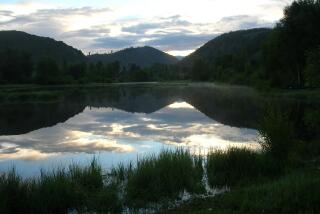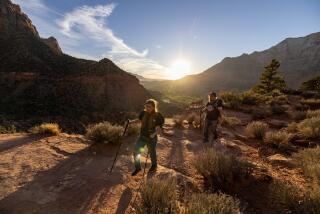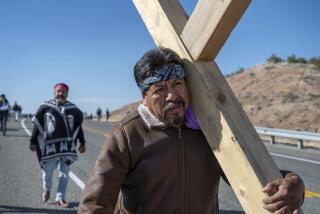The Route Stuff : Mormons Show Their Devotion by Retracing Steps of Historic Trek
- Share via
CYPRESS — Nancy Weaver plans to get away for a few days this summer to a place not off the beaten path, but directly on it. And in the process, she’ll be touching her own family history.
Weaver, husband Kurt and seven of their eight children will be among 5,000 people taking part in the Mormon Trail Reenactment, a 15-week wagon train to commemorate the 19th century migration of the Church of Jesus Christ of Latter-Day Saints from the Midwest to Utah.
That migration, which lasted 22 years, saw as many as 70,000 Mormons move into the Great Salt Lake Valley. Portions of the route they followed, now a National Historic Trail, are still visible, including foot-deep ruts in parts of western Wyoming.
For Weaver, as for several Orange County families participating in the reenactment, the trek takes on dimensions more personal than simple church history, bringing into focus some of the deprivations and sacrifices her ancestors suffered for the sake of their faith.
“If it weren’t for them, we might not be in the church today,” said Weaver, of Cypress, a Mormon who has been reading family memoirs of the migration to prepare for her own trek. “It’s just so that we can feel some of what our ancestors went through for us, for our freedom of religion.”
The reenactment begins Saturday near Council Bluffs, Iowa, at a former staging area for pioneers preparing to enter the Great Plains. Church members will take part in different portions of the march, ending July 22, when the train of horses, wagons and handcarts enters the Valley of the Great Salt Lake--150 years to the day after the first of the Mormons arrived.
Participants--400 to 500 at any given time--will pay from $7.50 per day to walk or pull replica handcarts to $25 per day to ride in the 35 covered wagons, said Brian Hill, who heads the trip’s organizing committee. The rest of the $300,000 budget will be covered by private and corporate donations, he said.
The reenactment has raised concerns about possible effects on environmentally sensitive areas, particularly in the Rockies. Hill said organizers are aware of those areas and have limited the number of participants to minimize possible damage.
“We’ve been working carefully with the Bureau of Land Management to make sure that we don’t have an excessive number of people,” said Hill, a professor of tourism at the University of Nebraska at Kearney. “We’ve turned away hundreds of people because we’ve filled up the number of people we can have without impacting the trail and the environment.”
Hill said the decision to use a wagon train to reenact the migration stems from similar events marking other recent anniversaries, including the sesquicentennial of the Oregon Trail in 1992.
“It’s been a popular way to celebrate,” Hill said.
*
Behind the Mormon celebration, though, lurks a dour history of oppression and violence.
The migration arose in response to vicious attacks and repression spawned by anti-Mormon sentiments that surfaced shortly after Joseph Smith founded the religion in 1830 in the Finger Lakes region of upstate New York.
After fleeing persecution in Ohio and Missouri, Smith’s growing church found a few years of peace in the town of Nauvoo, in the southwestern part of Illinois. But persecution revived and Smith himself was killed by a mob in 1844.
Brigham Young succeeded Smith as leader of the main body of the church and began plans to move the faithful farther west.
Forced from Nauvoo in February 1846, before they were ready, the Mormons slowly made their way across Iowa and set up camp near Council Bluffs as they prepared for the final push to the Rocky Mountains. On April 5, 1847, Young, 142 other men, three women and two children set out on the 1,000-mile trip to Utah.
Among that initial troop of pioneers was an ancestor of Kimberly Nitta of Cypress, who, with her family, will retrace some of the steps herself.
“We just really have a lot of excitement about the sacrifices that the saints made, and that’s what’s motivating us,” said Nitta, who will make the trip with her husband and their five children. “We wanted to walk the walk and talk the talk, so to speak.”
*
Nitta has sewn period outfits for her family to wear on the reenactment. And like many families, they will pull a replica handcart of the human-powered wagons the original pioneers used to ferry supplies along the trail.
The Nittas will walk a section of the trail in Wyoming that’s inaccessible by car. Their oldest child will be 15 then, the youngest 6.
“So it’s going to be interesting,” Nitta said, laughing. “We’re excited but there’s a little bit of fear. This is going to be real authentic. But I am wearing my Reeboks. I’m not going to wear pioneer shoes.”
William Wynder’s family will be going too, on a journey that will be part religious observance and part family lesson.
“It is an effort to give our children a flavor of what the Mormon pioneers went through for the sake of their religious convictions--and to help them connect and to help us, as their parents, with the religious traditions and history of the church,” said Wynder, who will walk for three or four days in early July with his wife and at least five of their seven children--including a 2-year-old.
The Wynders will cover a portion of the trail steeped in Mormon history--the spot along the Sweetwater River in Wyoming where two handcart companies were caught in winter weather. About 220 of 1,075 Mormons in the two companies perished before help arrived.
“There was a lot of hardship and a significant number of deaths because of the extremely heavy and cold winter snows,” Wynder said. “Although we will not be there at that time. We expect it will be beautiful.”
One of Nancy Weaver’s direct ancestors, Nancy Elston Hammer, was among those early pioneers.
“Her husband [Austin Hammer] had been killed back East by a mob at Haun’s Mill,” said Weaver, who has a copy of memoirs written by Hammer’s son. “It happened Oct. 30, 1838, while he was guarding a corn mill. They were guarding it to keep a mob from burning it.”
*
Hammer and her children, like other Mormons in Missouri at the time, were driven from their land. They went to Nauvoo but in 1846 were again forced out.
“They gave them several days to get off the land, and to take what they could,” Weaver said. “She had a blind horse, one wagon and seven children, and only the girls had shoes. The boys had to go barefoot, their feet wrapped with rags, through the snow.”
In one regard, history will repeat itself: The Weavers will be taking seven of their eight children with them this summer. One son, who is doing missionary work in England, won’t make it back.
“The younger ones are excited,” Weaver said. “The teenagers are saying why do we have to go walk through the dirt and heat? Once they get there, they’ll be excited. [Participants] will be telling a lot of the history at the campfire at night.”
Involving the children, she said, makes the journey part family outing, part homage to shared history and part embrace of agonies their ancestors suffered on their behalf.
“We’re kind of walking in their names,” she said.
More to Read
Sign up for The Wild
We’ll help you find the best places to hike, bike and run, as well as the perfect silent spots for meditation and yoga.
You may occasionally receive promotional content from the Los Angeles Times.







